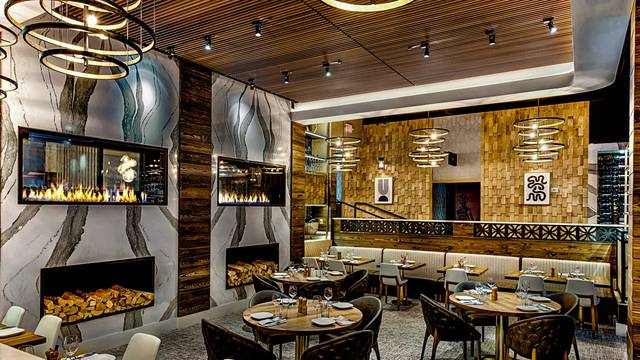Best Asian Restaurant Islamabad: Experience Tastes from Across Asia
Savor Authentic Oriental Food With a Pan-Asian Spin for a Culinary Experience
Beginning on a cooking trip with authentic Oriental food, improved with a Pan-Asian twist, offers a distinct chance to check out the rich tapestry of flavors that specify the area's varied cooking customs. As you contemplate these enticing recipes, take into consideration the social narratives and historical influences that form them, each bite using a story waiting to be discovered. Fine dining experience Islamabad.

Discovering Pan-Asian Flavors
In the world of international gastronomy, Pan-Asian cuisine stands out for its impressive variety and the harmonious interplay of flavors from various Asian cultures. This cooking method celebrates the abundant customs and unique active ingredients located across the continent, creating a tapestry of preferences that is both enjoyable and fascinating. Key to Pan-Asian food is its ability to balance contrasting tastes-- pleasant, salty, spicy, and sour-- while highlighting the freshness and quality of each component.
From the umami-rich soy sauce of Japan to the intense chili peppers of Thailand, Pan-Asian cuisine supplies a substantial scheme of flavors. These elements are typically combined in innovative methods, boosting recipes with layers of complexity. For example, making use of aromatic herbs such as lemongrass and cilantro, usual in Vietnamese and Thai cuisine, adds a rejuvenating illumination to meals, while the unification of coconut milk supplies a creamy, rich appearance.
The focus on fresh produce and aromatic spices makes sure that each meal is not just a banquet for the preference buds but likewise for the detects. Pan-Asian food welcomes restaurants to start a culinary trip, exploring the vast and varied landscapes of Oriental gastronomy with every bite.
Combination Dishes to Attempt
While Pan-Asian food is celebrated for its typical tastes, the modern-day cooking landscape is progressively embracing fusion dishes that mix these classic components with influences from other regions. This ingenious method not just honors the abundant heritage of Asian cookeries but likewise introduces novel taste experiences that appeal to modern tastes.
An archetype of such a combination dish is the Korean-Mexican taco, where marinaded bulgogi beef is covered in a warm tortilla, covered with kimchi and a spicy gochujang-infused salsa. This combination weds the strong, savory flavors of Korea with the vivid, fresh components of Mexican cuisine. In a similar way, sushi burritos have gotten popularity, amalgamating the delicate virtuosity of Japanese sushi with the hearty, hand-held comfort of a burrito, often including blend ingredients like tempura shrimp and avocado with a drizzle of wasabi mayo.
One more noteworthy meal is Thai curry ramen, which instills the luscious, aromatic flavors of Thai curry into the reassuring brew of traditional Japanese ramen, producing an unified mix that tantalizes the senses. These combination recipes expand beyond mere uniqueness; they represent a culinary discussion in between societies, encouraging exploration and technology in the world of Pan-Asian cuisine.
Crucial Ingredients and Flavors
To truly value Pan-Asian food, one need to recognize the essential active ingredients and spices that develop its structure. This varied culinary style attracts from a rich tapestry of Asian practices, employing a harmonious mix of flavors and structures. Key active ingredients consist of soy sauce, fish sauce, and oyster sauce, which present a tasty umami deepness important to Asian dishes. Complementary to these are rice vinegar and mirin, providing a fragile acidity and sweetness.
Aromatic components are critical, with garlic, lemongrass, and ginger being common across various Pan-Asian dishes. These ingredients offer a great smelling base that improves the complexity of site flavors. Spices such as celebrity anise, cardamom, and cinnamon introduce heat and character, echoing influences from areas like China and India.

Food Preparation Techniques and Tips
Grasping the art of Pan-Asian cuisine needs knowledge with its distinctive cooking techniques, each adding to the vibrant tapestry of tastes this culinary practice is commemorated for. Central to these approaches is the stir-fry, a quick cooking method that preserves the dietary integrity and dazzling shades of components. Making use of a frying pan, the stir-fry method enables even warm circulation, important for accomplishing the particular texture and flavor balance of Pan-Asian meals.
One more basic technique is steaming, especially common in Chinese cuisine. This mild technique preserves the natural flavors and nutrients of components, making it excellent for seafood and vegetables. Dumplings, a beloved staple, often benefit from steaming, leading to soft, succulent appearances.
Cooking, additionally essential, gives great smoky depths to meals such as Korean bulgogi or Japanese yakitori (Best ambiance restaurants Islamabad). This strategy usually includes seasoning ingredients, enabling flavors to penetrate deeply prior to cooking over an open fire or warmer
Lastly, understanding the art of balancing flavors-- pleasant, sour, salted, bitter, and umami-- is vital. Correctly layering these elements can raise a meal from regular to extraordinary, supplying a facility and satisfying culinary experience that personifies the essence of Pan-Asian cuisine.
Dining Experiences Worldwide
Throughout the globe, Pan-Asian food provides an unmatched eating experience, commemorated for its abundant tapestry of tastes and lively presentations. This culinary sensation has gone beyond cultural borders, catching the hearts and find tastes of food lovers worldwide. In cosmopolitan cities fresh York, London, and Sydney, Pan-Asian dining establishments act as fusions where cooking customs from Thailand, Japan, China, and past converge, supplying restaurants with an eclectic mix of recipes that highlight the region's diversity.
The global charm of Pan-Asian food depends on its capacity to supply both authenticity and technology. Cooks skillfully wed typical ingredients such as lemongrass, soy sauce, and miso with contemporary strategies, leading to recipes that are both refreshingly new and familiar. This combination enables restaurants to get started on a cooking journey that appreciates heritage while embracing modernity.
In addition, dining experiences are raised with attentively created settings that mirror the ethos of Pan-Asian aesthetic appeals. From minimalist Japanese-inspired interiors to dynamic Thai-themed rooms, each restaurant offers an unique ambiance that enhances the cooking offerings. Because of this, clients are not just eating a dish but partaking in a social experience, making Pan-Asian dining a really international phenomenon.
Conclusion
The expedition of Pan-Asian food uses an extensive understanding of the intricate interaction of tastes and culinary traditions across Asia. By embracing blend recipes such as Thai curry ramen and sushi burritos, the culinary journey not only highlights the adaptability of traditional active ingredients however additionally showcases innovative modern strategies. This gastronomic journey, enhanced by cooking techniques and essential seasonings, offers a special opportunity to value the cultural variety and cooking creativity that define Pan-Asian cuisine on a global range.
Getting started on a culinary trip through genuine Oriental cuisine, boosted with a Pan-Asian twist, supplies a distinct opportunity to discover the abundant tapestry of flavors that specify the region's diverse cooking traditions.In the world of worldwide gastronomy, Pan-Asian cuisine stands out for its remarkable diversity and the unified interaction of flavors from different Asian societies. Trick to Pan-Asian cuisine is its capacity to balance different tastes-- pleasant, salted, spicy, and sour-- while highlighting the quality and quality of each active ingredient.
